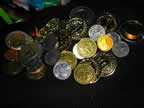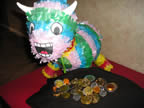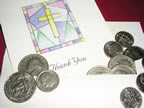|  


|
 |
Baptism
An insight into money and religion.
by Leon Kitain, Victoria Sauer, Raul Perez, Rishi Ram and Joan Lim
I. Introduction
The day dawned crisp and clear, the fresh wind seeming to blow all cares and worries away. In front of the church thronged people, maybe fifty, maybe one hundred, and maybe even several hundred. The morning sermon had ended, yet, if possible, the number of people only seemed to increase. They milled around, talking to each other in Spanish, laughing and enjoying this time spent together with their friends and family. For those who are hungry, outdoor stands selling various refreshments and more traditional Mexican food were available. Suddenly, our eyes were riveted to a spot of white. Children, from the ages of just one month, to several years, walked along, herded by their parents, wearing pure alabaster finery, clearly excited about some kind of occasion about to take place. As they entered the church, we followed them inside.
The church itself is nothing to be trifled with. Built by someone well involved with modern architecture, it gave a feeling of empty space and freedom, more so than one would think from the outside. At the front of the church was kind of pool, standing close to the stage with the pulpit. As the party with white clan children sat down, us following them, the din outside started to die down, and the preacher began to speak. He talked of commitment, and of faith, saying that today’s ceremony would cement the children in white as spiritual members of the church, and set them on the appropriate path of faith in their future life.
He then turned to a group of adults, a pair of male and female per child, and asks them if they are Christian enough to guide their godchildren through moral difficulties. Upon hearing a hearty yes, he turned to the children, crossed their foreheads, crossed the foreheads of the godparents and urged his assistants to begin moving the children to the pool. The moment is nigh, and soon, these children shall be anointed with water, and become spiritual beings. As you may have realized from the above description, this is a recounting of a Mexican baptism, and a pretty standard one of its type. As the children are baptized, the whole procession would move out to the church doors, where the godparents would scatter bolos on the ground outside, for all the children of the relatives and friends to excitedly pick up. Unfortunately, traditions change, and the scattering of coins after a baptism, referred to as bolos in Spanish, now tends to happen at after baptismal parties, or sometimes not at all. In this paper, we will explain the practice, guess at its social meanings, and the reasons for its evolution.
II. Interviews
In order to fully comprehend bolos and what it means to people, there is no better way than asking those that have either thrown bolos, or picked it up when they were children, or will do so in the near future on their opinions. Below are a set of interviews conducted either next to a Hispanic church, or with people who would seem to be knowledgeable about their culture.
The first two people interviewed were a pair of Mexican American Spanish teachers over the phone. The first thing we queried them on was the selection of the godparent. According to them the godparents must be of the same religion as the family, and they should be either relatives or close friends. The duties of these people are to provide financial and religious support, if needed, as the child grows up. They also stated, that the family will be blessed, if a godparent asks to be a godparent before you were thinking of asking them to fill in that role. Furthermore, the family should not look at socioeconomic status when choosing a godparent, even though most of your family and close friends will end up being about as rich as you are.
The next question we inquired about was bolos itself. Godparents are expected to start saving before the baptism, mostly quarters and dimes in the US, in order to have enough money to throw at the baptism. Outside of the bolos, the godparents also need to pay for baptismal gown, the candles, the prayer books, the concha shell, remembrances, as well as depending on the church, going half and half with the church donation. For the bolos it would be thrown like rice at weddings if in front of church, or off the patio if at a house party. These days, the respondents told us, more often than not bolos is divided evenly, put into little envelopes, and given to each child. Another variation of this practice seems to be sticking the bolos into a piñata along with the candy, as to make this more of a party game.
When asked what the bolos represents, and what kids do with it, the answers we received from these two teachers were somewhat more vague. The kids are either supposed to spend the money, buying candy and other treats, or give it to their parents to be saved for them. As for the meaning, there are two that came up in this interview. If thrown outside of the church, the bolos are supposed to give good luck not only for the baby, but for his/her family. If at a party, than the luck of bolos is said to extend to everyone present at the occasion.
The second set of interviews was administered to a group of Hispanic immigrants outside of a church, doubling as a community center, on a weekday. The first interviewee refused to talk about bolos itself, claiming it was irrelevant in the greater realm of things, considering how holy and important the whole tradition of baptism was to the child and the family. The next two people grew up in a small village in Mexico with a traditional upbringing, and they had a very different view of bolos. To them, the throwing down of coins at a child's baptism would guarantee that he had friends as he grew up in that same community. Furthermore, in such a village, all the people there attended every baptism, not just friends and family.
The next person asked had an even different conception of the reason behind bolos. She said that bolos were distributed so that the child would not grow up to be a 'cheapskate', and would know the proper value of money. At the same time she also mentioned that if the godparents gave too little bolos, they would be socially stigmatized for not knowing when and how much to give. Another person chimed in that in her family, special coins were bought for this occasion, and put into envelopes to give out to every single attendee as remembrances. Finally, when we talked with one of the food vendors, he replied that nowadays bolos are not thrown because of practical considerations, namely the fact that no one is there to clean up the outside of the church afterwards.
The next set of interviews was done with UCI students majoring in Chicano-Latino studies here. Their families were both born in Jalisco region of Mexico, but our respondents were raised in different areas on the USA and thus have different views on baptism. The girl never attended a ceremony where there was bolos thrown, but she stressed how important it was for the godparents to arrange a fiesta after the ceremony, and even if they did not have the money to pay for it, they were socially obligated to borrow money in order to bankroll the event. The guy talked about his recent experience as a godfather to one of his cousin’s children, and how it was a truly special bond to be selected for the roll. He did throw bolos, but since he is a starving college student, he only donated 10 dollars, while the godmother took care of the rest of the money.
The final interview involved the very member of our group that suggested the project in the first place. He talked about how much he enjoyed bolos when he as a kid, because he was always a bit older than his cousins, and could grab a bigger share of the money for himself. His parents always encouraged him to save the money, but he always spent it on candy and snacks. When he became a godfather himself, he decided to instead of throwing bolos, to just give the money to his aunt so she could buy snacks for the children at the party directly.
Research
When trying to find any sort of information about the practice of bolos, it is inescapable that it is described in the context of a baptism. Thus, the first thing we researched was the practice of the Mexican baptism. The best definition of the baptism was found in a website focusing on dealing with Hispanic cultures. The website claims that
A child's "Bautismo" is one of the seven religious sacraments and is celebrated for a newborn child being initiated into the spiritual community of the Catholic Church. The role of the "compadrazgo" or godparents involves the duty of raising the child if the child's parents were to die. This creates an extended family bond. (National Multicultural Interpreter Project, 2000)
Another source goes on to note that being chosen a godparent of a child is the highest honor that can be bestowed on a person. At the same time, it claims that since being assigned this duty means you have to meet certain financial obligations, namely throwing a huge party, some baptisms are delayed one or two years for the godparents to save enough money to pay for this. The website goes on to state that “the importance of a Padrino and a Madrina is brought out by the fact that many Mexican people in the Southwest are more accurate in remembering the names of their godparents than those of their parents.” (Bernard, 1955)
The next piece we looked at clarifies the bond that is shared between the godchild and his godparents. It announces that “urban residents find it beneficial to use the compadrazgo to strengthen ties with some of their kinsmen while also using this mechanism to build social bridges with friends and colleagues.” (Kemper, 1982) Basically, this article depicts a story of the godparent ritual to be used in order to build social and economic ties, under the facet of true religiosity. Nonetheless, it does not state that the families who choose a godparent are ‘gold diggers’; on the contrary, they try to look for someone who is of the same economic status as them.
So where does the bolos factor into all of this? According to Madsen, “outside of the church, the godfather presents a gift of money, called a “bolo,” to the priest, the sacristan, and any bystander who requests it, saying “A bolo grandfather, so that your godchild may live.”” Curiously, Madsen also notes that the ceremony of giving coins is repeated at the godson’s marriage by the godfather, when “the godfather gives several coins to the priest, who pours them into the grooms cupped hands... This rite symbolizes the money which a man brings his wife.” (Madsen, 1960) The first source cited seems to elaborate on this matter, stating that the donation of the coins to the neighborhood urchins establishes good will toward the child, and is a sign of prosperity to come.
Zelizer, in her book The Social Meaning of Money comments on the importance of money as gift giving. She mentions that giving money was only initially appropriate between close friends and family, noting the Christening was a good time for the godfather to give money to the family. She goes on to remark that “gift money was thus a distinct currency earmarked for friends and kin, reinforcing the intimacy of particular social ties.” (Zelizer, 1997) This goes hand in hand with the book above which talks about bolos and social ties.
Analysis
As we can see in the above two sections, the bolos is inseparable from baptism in people’s minds. The baptism to them is a sacred ceremony that is necessary for the proper moral Christian upbringing of a child. The weight of that burden falls upon the godparents, who symbolically agree to their commitment through paying for the ceremony and the party afterwards. At the same time, in order to bless the child, they scatter bolos.
There is no one explanation for what the bolos will do. Some of our respondents continually told us that it is just tradition and all it gives is luck. To us, it seemed that the people who said this are those who were less in touch with their cultural norms, and had less interest in the past. One person even went far enough as to tell us that bolos is given for the sake of keeping the bolos tradition alive and no more. On the other hand, those people who were more involved in the rituals, like the two men from a rural village saw bolos as something more, something necessary for the child to be accepted in the future.
Our book research focuses on the socioeconomic ties between the godparents and their godchildren. Thinking about that, we can guess that the bolos tradition evolved out of the need for some sort of physical reaffirmation of that tie, hence the scattering of the coins for the children to pick up. Zelizer, chiming in, describes money building bonds, building an image, in our minds at least, of every dropped coin picked up by a child of a relative or a friend as a tentacle of good will and social grace binding the child and his future relations.
The evolution and partial disassociation from the bolos ritual in modern baptisms can be seen as an indicator of the dissolution of traditional community values. The families whose baptism we attended last Sunday told us that it was a Sunday night and they could not throw a fiesta simply because they had work the next day. They would have a small dinner between just the immediate family and the godparents and end the ceremony without any further ritual. And while there has been no research on the correlation between the bolos ceremony and community closeness, we would be willing to wager that 50 years ago when it would be unheard of not to throw bolos, the surrounding families were closer together, and could ask each other for more help if necessary.
But whether just luck, or tradition, whether there are social bonds being forged or not, whether the tradition will continue in the future, no one could deny that throwing bolos is great fun. As we all watched in delight as our team member described his experiences picking up the bolos as a child and throwing them years later as a godfather, no one could ignore the silly grin on his face as he recounted how fun the whole activity was!
|
 |






